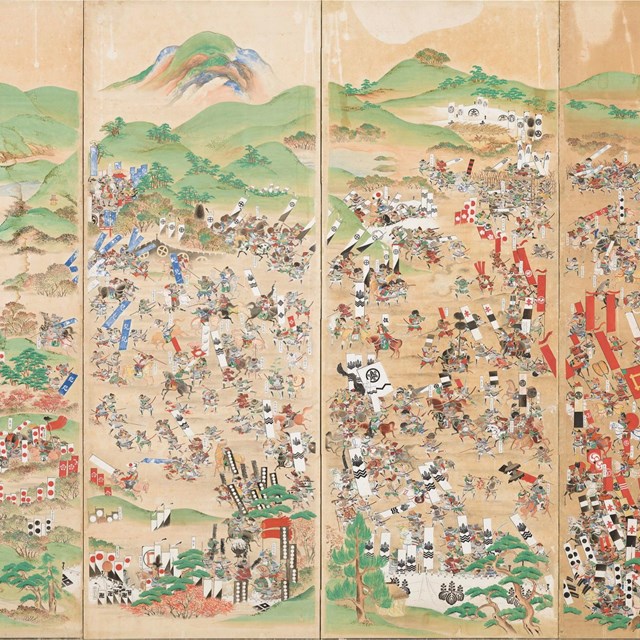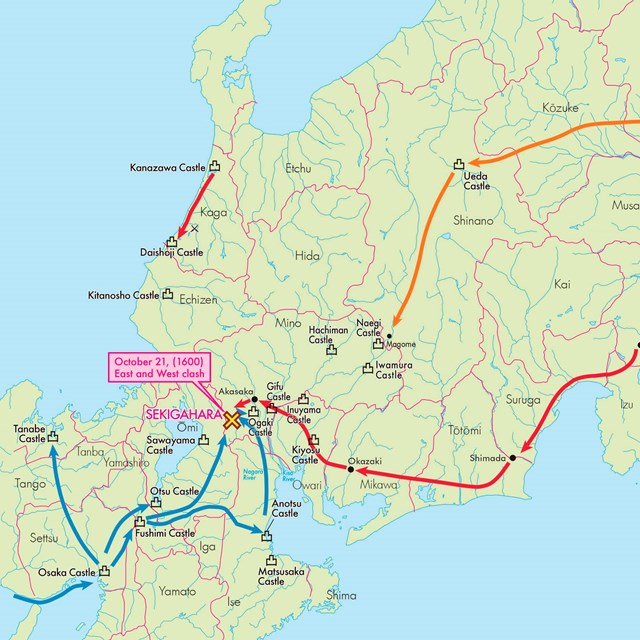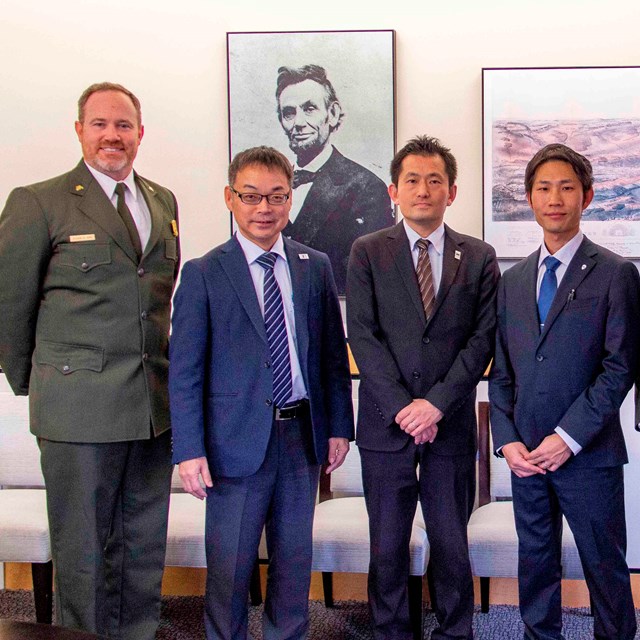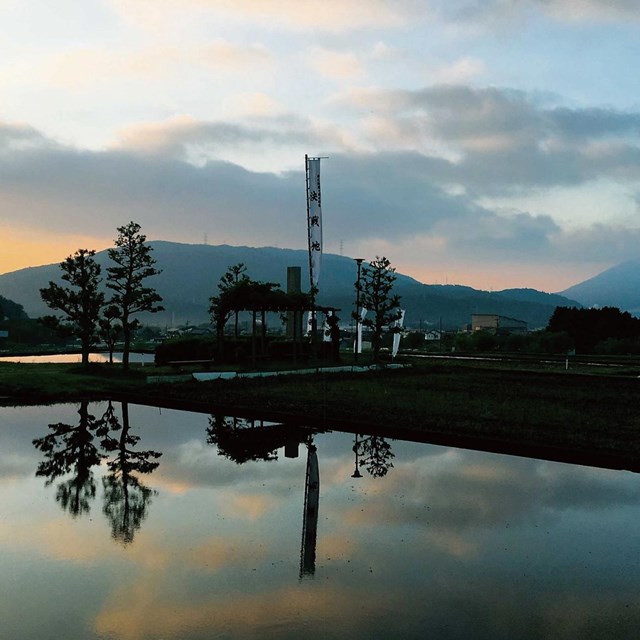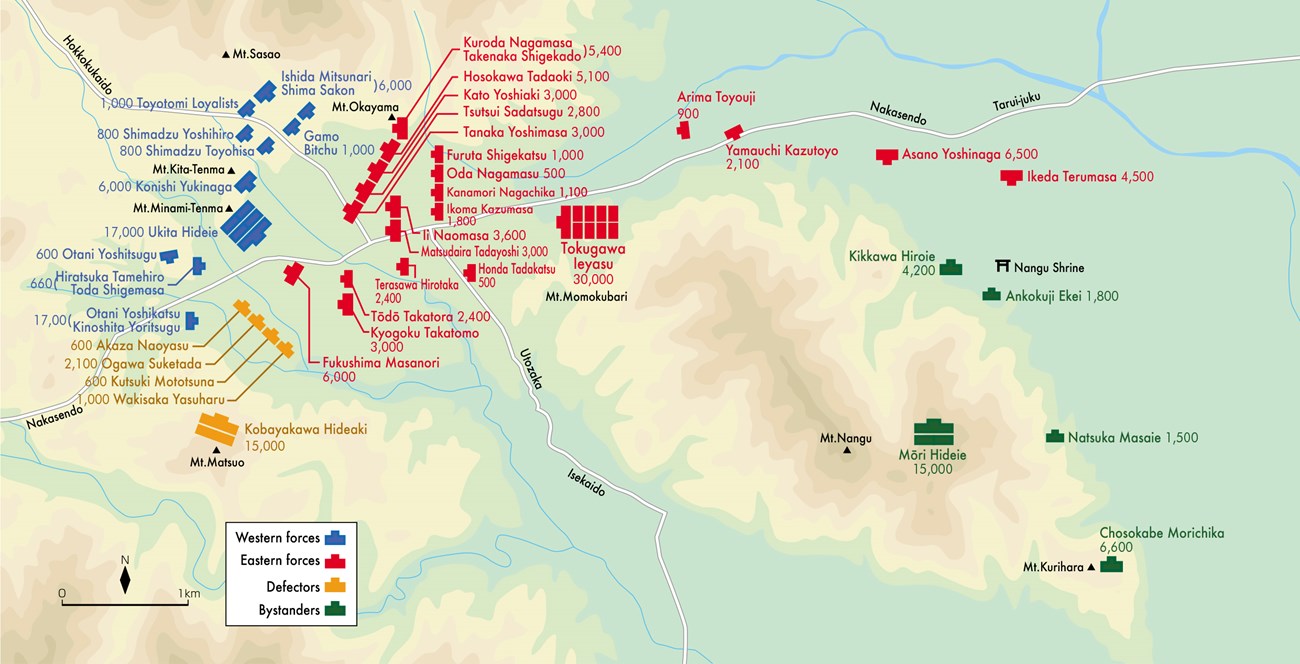
Gifu Sekigahara Battlefield Memorial Museum Image When Ishida Mitsunari withdrew his Western Army from Ogaki castle on the evening of October 20, 1600, he knew that his opponent Tokugawa Ieyasu's Eastern Army had little choice but to follow. Ieyasu’s objectives, the Ishida headquarters at Sawayama and the city of Osaka, lay at the end of the Nakasendo, and if he wanted to reach them, he had no choice but to confront the Western Army, which would be waiting for him near Sekigahara. The Western Army’s approximately 80,000 men worked tirelessly in the darkness of that late, rainy night, taking up positions around the four hills overlooking the valley around the road through Sekigahara. Kobayakawa Hideaki, the 18-year-old veteran of the recent war in Korea, led about 15,600 men from his headquarters on Matsuoyama (Mount Matsuo) on the far-right flank of the Western Army. Several days before the battle, Hideaki had sent a message to Ieyasu saying that when the time came, he would join the Eastern Army in return for a reward of massive wealth and land. Hearing rumors of treachery, soon before the battle Mitsunari extracted a promise from the young general that he would remain loyal to the Western Army and would charge at the Tokugawa flank once Mitsunari lit a signal fire. By the dawn of October 21, neither side knew where Hideaki’s true loyalties lay, least of all Hideaki himself. 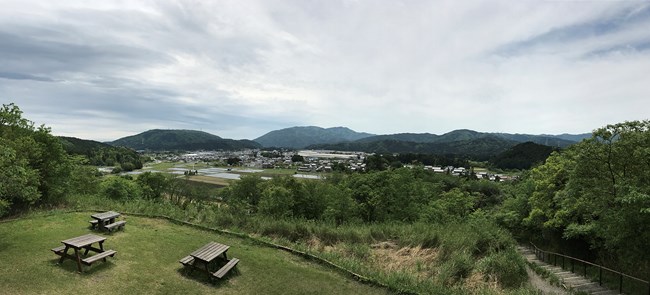
Gifu Sekigahara Battlefield Memorial Museum Image By 4:30 a.m., the Western Army had essentially created a wall blocking Ieyasu from following the Nakasendo. With the two armies having essentially equal numbers – about 80,000 men each – the advantage in terrain seemed to belong to Mitsunari. But numbers and terrain are not the only consideration in such battles. For his part, Ieyasu began to pursue Mitsunari at around 2:00 a.m. on October 21, setting up his command post on a small hill called Momokubari next to Nanguyama. His generals set up a line across the Nakasendo parallel to the Western forces in front of them. Ieyasu himself directly commanded about 30,000 men. Around 13,500 others took up positions on the road behind him just in case the Western Army’s Mori forces, whom Ieyasu had ostensibly convinced to join him, reneged on their promise. About 20,000 men under Fukushima Masanori, Kuroda Nagamasa, Tanaka Yoshimasa, Hosokawa Tadaoki, Katou Yoshiaki, and Tsutsui Sadatsugu took up positions facing Mitsunari between Sasaoyama and the village of Sekigahara, with some 18,000 men behind them closer to the town. 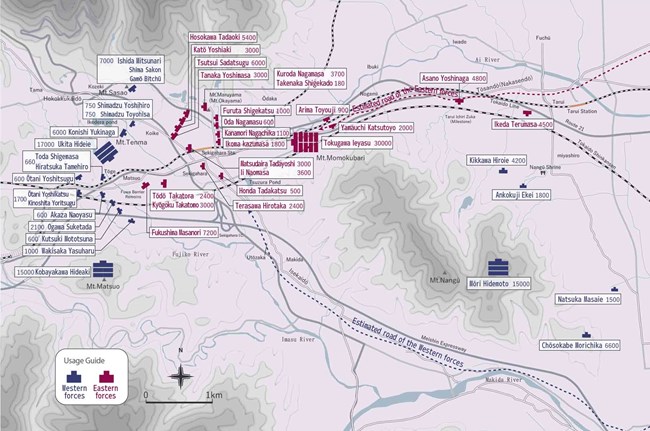
Gifu Sekigahara Battlefield Memorial Museum Image 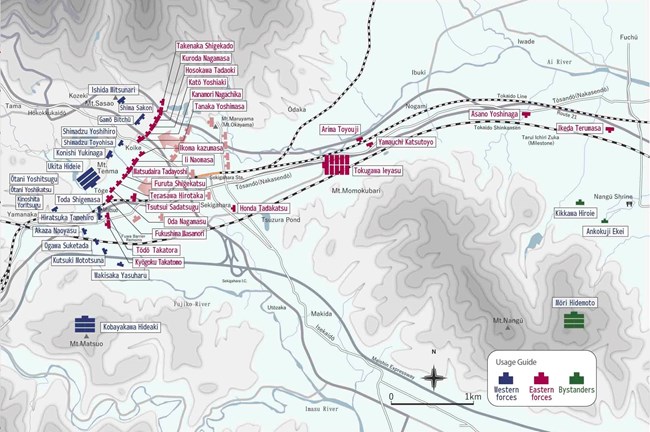
Gifu Sekigahara Battlefield Memorial Museum Image One typical example of the brutality of close-quarters combat during this period came early in the battle during this clash between the Ukita and Fukushima forces. Kani Saizo, one of Masanori’s officers, fought against his counterpart Akashi Takenori. Stabbing and slashing his naginata – a Japanese polearm – against Takenori’s attempts to block and parry, Saizo finally knocked him to the ground and cut the head off of his wounded opponent. It was a traditional custom during this period for warriors in combat to claim the heads of their slain foes. At the end of a battle, all the captured heads would be registered and presented to the army’s leader, with more merit and honor going towards those fighters who had claimed the heads of the highest rank. By the end of the battle, Saizo alone had seized 17 enemy heads. Ninety minutes into the battle, Shima Sakon, who had advised Mitsunari against a night attack near Ogaki castle, became an early casualty for the Western forces, and a bad omen for the course of the battle. Caught in a volley from Eastern matchlocks, he received gunshot wounds to his chest and elbow and was knocked from his horse. His men quickly carried the wounded general off the battlefield, but his injury dealt a blow to Western morale. To rally his own side, Ieyasu moved his command post forward to just outside the village. All this time, the Western forces to the east on and around Nanguyama – about 25,000 men – had been standing idle, even as the Eastern Asano Yukinaga began to attack their ally on the slopes, Natsuka Masaie. None of them dared to fight unless Kikkawa Hiroie, who had taken position in front, acted first. Eventually, Hiroie’s impatient allies sent him messages inquiring whether he intended to fight at all. Not once but three times throughout the battle, he replied that he was not yet ready: he and his men were in the middle of eating lunch. Another important general who was conspicuously inactive during the early battle was Kobayakawa Hideaki on Matsuoyama. Even after Mitsunari fired signal flares into the sky and both Otani Yoshitsugu and Konishi Yukinaga sent messengers up Matsuoyama, the Kobayakawa forces made no sign of movement. Having sworn allegiance to both the Tokugawa and the Toyotomi loyalists, and, in turn, having been promised rewards from both, the young Hideaki seemed unable to make up his mind as to which side he was on. On the Western left, next to Mitsunari’s position, Shimazu Yoshihiro and his 2,000 men were also immobile despite the many orders they received from their nominal commander to join the fray. Eventually, around 11:00 a.m. Mitsunari himself rode out to demand answers from Yoshihiro. Yoshihiro declared that "there have been too many unpleasant dealings between us, I won’t fight for the likes of you!” 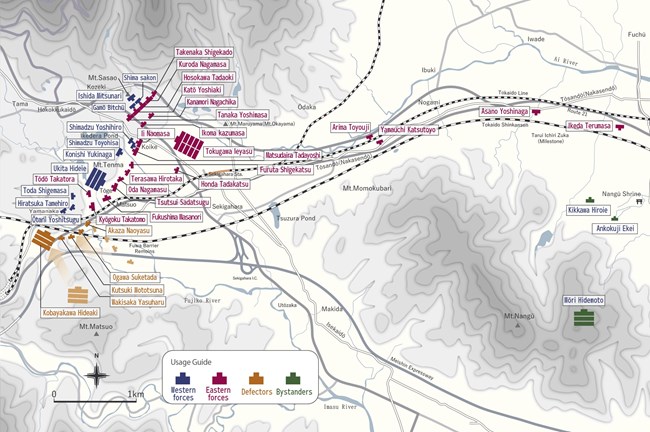
Gifu Sekigahara Battlefield Memorial Museum Image Finally, Kobayakawa Hideaki made his decision, ordering his men to charge down Matsuoyama and attack Otani Yoshitsugu. Although the leprous Yoshitsugu had anticipated Hideaki’s treachery and effortlessly adjusted his lines to guard his flank, Hideaki’s 15,000 men horribly outnumbered Yoshitsugu’s 600, even without the Eastern forces attacking them in the front. Knowing hope was lost, Yoshitsugu committed seppuku and asked one of his retainers to hide his head so that the Eastern forces would not claim it as a trophy. He was apparently successful, as his head was never found. 
Yoshitoshi's 'Selection of 100 Warriors' The 28,000 Western forces on Nanguyama, despite their strength, numbers, and ideal position in Ieyasu’s rear, had done virtually nothing the whole battle. Indeed, Kikkawa Hiroie had been a turncoat all along and had promised Ieyasu not to fight the Eastern army as an attempt to secure a more favorable position for the Mori clan in the new Tokugawa-dominated Japan. Seeing that the battle was over, the Mori also took their leave of the battlefield. At 2:30 p.m., the victorious Tokugawa Ieyasu conducted the head-viewing ceremony. About 30,000 men lay dead, more than four times the number of deaths at the Battle of Gettysburg. Ieyasu had crushed the last, greatest threat to his power. In the years to come he would be declared shogun by the emperor and would annihilate the last vestiges of the Toyotomi loyalists, including Hideyori himself, at the Siege of Osaka in 1615. 
Gifu Sekigahara Battlefield Memorial Museum Image All of that was in the future, however, and Ieyasu knew always to expect the unexpected. Even as he overlooked the bloody field, finally triumphant, he sternly tightened the cords of his helmet as if prepared for more fighting. “Katte kabuto no o wo shime yo,” he said, in a phrase that would become a Japanese idiom. “Tighten the strings of your helmet after victory,” because, after all, you never know what could happen next. The defeated Ishida Mitsunari delivered a similar sentiment soon after the battle, when he was captured and awaiting execution. Offered persimmons as a courtesy before his death, Mitsunari declined, insisting that they would be bad for his digestion. Konishi Yukinaga, who was to be beheaded as well, was incredulous, asking how Mitsunari could be so concerned about digestion when he was going to be dead in a few moments. “You never know what will happen,” Mitsunari replied. Learn more about Sekigahara
|
Last updated: May 5, 2025

